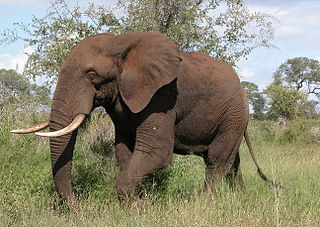
The Proboscidea are a taxonomic order of afrotherian mammals containing one living family (Elephantidae) and several extinct families. First described by J. Illiger in 1811, it encompasses the elephants and their close relatives. From the mid-Miocene onwards, most proboscideans were very large. The largest land mammal of all time may have been a proboscidean; Palaeoloxodon namadicus was up to 5.2 m (17.1 ft) at the shoulder and may have weighed up to 22 t, almost double the weight of some sauropods like Diplodocus carnegii. The largest extant proboscidean is the African bush elephant, with a record of size of 4 m (13.1 ft) at the shoulder and 10.4 t. In addition to their enormous size, later proboscideans are distinguished by tusks and long, muscular trunks, which were less developed or absent in early proboscideans.

A mastodon is any proboscidean belonging to the extinct genus Mammut that inhabited North and Central America during the late Miocene or late Pliocene up to their extinction at the end of the Pleistocene 10,000 to 11,000 years ago. Mastodons lived in herds and were predominantly forest-dwelling animals. They generally had a browsing diet, distinct from that of the contemporary Columbian mammoth, which tended towards grazing.

Deinotherium was a large elephant-like proboscidean that appeared in the Middle Miocene and survived until the Early Pleistocene. Although superficially resembling modern elephants, they had notably more flexible necks, limbs adapted to a more cursorial lifestyle as well as tusks that curved downwards and back. In addition, their tusks didn't emerge from the maxilla as in elephants but from the mandible. Deinotherium was a widespread genus, ranging from East Africa to the south to Europe and east to the Indian Subcontinent. They were browsing animals with a diet mainly consisting of leaves, and they most likely died out as forested areas were gradually replaced by open grassland during the latter half of the Neogene.
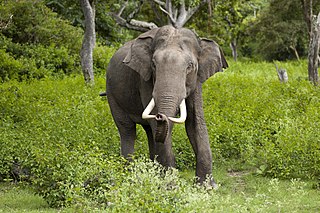
Elephantidae is a family of large, herbivorous proboscidean mammals collectively called elephants and mammoths. These are terrestrial large mammals with a snout modified into a trunk and teeth modified into tusks. Most genera and species in the family are extinct. Only two genera, Loxodonta and Elephas, are living.

Mammutidae is an extinct family of proboscideans that appeared during the Oligocene epoch and survived until the start of the Holocene. The family was first described in 1922, classifying fossil specimens of the type genus Mammut (mastodons), and has since been placed in various arrangements of the order. The name "mastodon" derives from Greek, μαστός "nipple" and ὀδούς "tooth", as with the genus, referring to a characteristic that distinguishes them from allied families. The genus Zygolophodon has also been assigned to this family. Mammutids ranged very widely, with fossils found in North America, Africa, and throughout Eurasia.

Moeritherium is an extinct genus of primitive proboscideans. These prehistoric mammals are related to the elephant and, more distantly, sea cows and hyraxes. They lived during the Eocene epoch.

Stegodon is an extinct genus of proboscidean, related to elephants. It was originally assigned to the family Elephantidae along with modern elephants but is now placed in the extinct family Stegodontidae. Like elephants, Stegodon had teeth with plate-like lophs that are different from those of more primitive proboscideans like gomphotheres and mastodons. The oldest fossils of the genus are found in Late Miocene strata in Asia, likely originating from the more archaic Stegolophodon, shortly afterwards migrating into Africa. While the genus became extinct in Africa during the Pliocene, Stegodon remained widespread in Asia until the end of the Pleistocene.
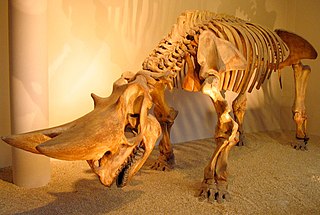
Arsinoitherium is an extinct genus of paenungulate mammals belonging to the extinct order Embrithopoda. It is related to elephants, sirenians, hyraxes and the extinct desmostylians. Arsinoitheres were superficially rhinoceros-like herbivores that lived during the Late Eocene and the Early Oligocene of North Africa from 36 to 30 million years ago, in areas of tropical rainforest and at the margin of mangrove swamps. A species described in 2004, A. giganteum, lived in Ethiopia about 27 million years ago.

Deinotheriidae is a family of prehistoric elephant-like proboscideans that lived during the Cenozoic era, first appearing in Africa, then spreading across southern Asia (Indo-Pakistan) and Europe. During that time, they changed very little, apart from growing much larger in size; by the late Miocene, they had become the largest land animals of their time. Their most distinctive features were the downward-curving tusks on the lower jaw.

Prodeinotherium is an extinct representative of the family Deinotheriidae that lived in Africa, Europe, and Asia in the early and middle Miocene. Prodeinotherium, meaning "before terrible beast", was first named in 1930, but soon after, the only species in it, P. hungaricum, was reassigned to Deinotherium. During the 1970s, however, the two genera were once again separated, with Prodeinotherium diagnosed to include Deinotherium bavaricum, Deinotherium hobleyi, and Deinotherium pentapotamiae, which were separated based on geographic location. The three species are from Europe, Africa, and Asia, respectively. However, because of usage of few characters to separate them, only one species, P. bavaricum, or many more species, including P. cuvieri, P. orlovii, and P. sinense may be possible.
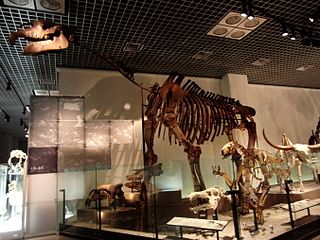
Paraceratherium is an extinct genus of hornless rhinoceros. It is one of the largest terrestrial mammals that has existed and lived from the early to late Oligocene epoch. The first fossils were discovered in what is now Pakistan, and remains have been found across Eurasia between China and the Balkans. It is classified as a member of the family Paraceratheriidae. Paraceratherium means "near the hornless beast", in reference to Aceratherium, the genus in which the type species P. bugtiense was originally placed.

The Columbian mammoth or the imperial mammoth is an extinct species of mammoth that inhabited the Americas as far north as the Northern United States and as far south as Costa Rica during the Pleistocene epoch. It was one of the last in a line of mammoth species, beginning with Mammuthus subplanifrons in the early Pliocene. DNA studies show that the Columbian mammoth was a hybrid species between woolly mammoths and another lineage descended from steppe mammoths; the hybridization happened more than 420,000 years ago. The pygmy mammoths of the Channel Islands of California evolved from Columbian mammoths. The closest extant relative of the Columbian and other mammoths is the Asian elephant.
Numidotheriidae is an extinct family of primitive proboscidean that lived from the late Paleocene to the early Oligocene periods of North Africa.

Barytherium is a genus of an extinct family (Barytheriidae) of primitive proboscideans that lived during the late Eocene and early Oligocene in North Africa. The type species is Barytherium grave, found at the beginning of the 20th century in Fayum, Egypt. Since then, more complete specimens have been found at Dor el Talha, Libya. More fossils were also discovered in 2011 in the Aidum area in Dhofar by Oman's Ministry of Heritage and Culture, which was named Barytherium omansi.
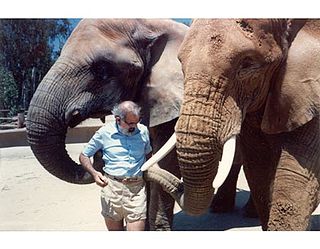
Jeheskel "Hezy" Shoshani was an evolutionary biologist who studied elephants and their relatives for over 35 years.
Eogavialis is an extinct genus of eusuchian crocodylomorph, usually regarded as a gavialoid crocodylian. It superficially resembles Tomistoma schlegelii, the extant false gharial, and consequently material from the genus was originally referred to Tomistoma. Indeed, it was not until 1982 that the name Eogavialis was constructed after it was realised that the specimens were from a more basal form.

Notiomastodon is an extinct proboscidean genus of gomphotheres endemic to South America from the Pleistocene to the beginning of the Holocene. Notiomastodon specimens reached a size similar to that of the modern Asian elephant. Like other brevirostrine gomphotheres such as Cuvieronius and Stegomastodon, Notiomastodon was characterized by its short snout and tall, highly arched skull. The short jaw was due to the loss of the lower tusks found in more primitive gomphotheres.

Stegodontidae is an extinct family of proboscideans from Africa and Asia from the Miocene (15.97 mya) to the Late Pleistocene, with some studies suggesting that some survived into the Holocene in China, although this is disputed. It contains two genera, the earlier Stegolophodon, known from the Early Miocene of Asia and the later Stegodon, from the Late Miocene to Late Pleistocene of Africa and Asia which derived from the former. The group is noted for their plate-like lophs on their teeth, which are similar to elephants and different from those than of other extinct proboscideans like gomphotheres and mastodons. This similarity with modern elephants may have been convergently evolved, however.

Elephantinae is a subfamily of mammals in the family Elephantidae and includes the largest existing land animals. Three species are currently recognised: the African bush elephant, the African forest elephant, and the Asian elephant. Elephantidae is the only surviving family of the order Proboscidea; extinct members include the mastodons. The family Elephantidae also contains several now-extinct groups, including the mammoths and straight-tusked elephants. African elephants have larger ears and concave backs, whereas Asian elephants have smaller ears, and convex or level backs. Distinctive features of all elephants include a long trunk, tusks, large ear flaps, massive legs, and tough but sensitive skin. The trunk, also called a proboscis, is used for breathing, bringing food and water to the mouth, and grasping objects. Tusks, which are derived from the incisor teeth, serve both as weapons and as tools for moving objects and digging. The large ear flaps assist in maintaining a constant body temperature as well as in communication. The pillar-like legs carry their great weight.



















